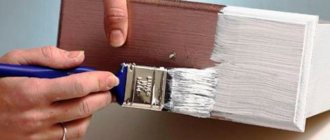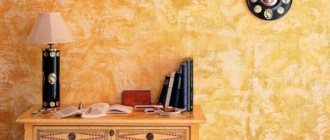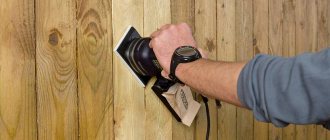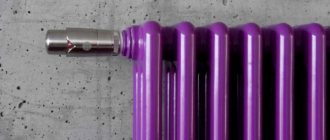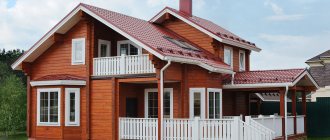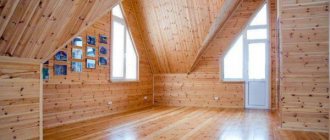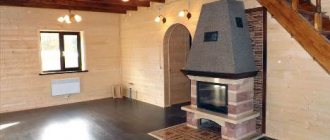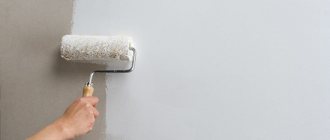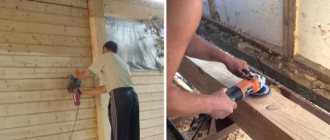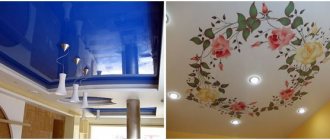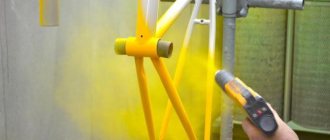Glued laminated timber is a special building material whose pleasant appearance and high performance indicators make it possible not to carry out any finishing work. But some people still want to give such a building more individuality. In this case, painting the laminated veneer lumber would be an ideal option. In addition to changing the color of the walls and improving the appearance, the compositions used for painting significantly extend the life of the building.
This method is the simplest and quite cheap, but it allows you to protect the wood from the negative effects of temperature, sunlight, moisture and wind. In this article we will talk about how to properly paint a house made of laminated veneer lumber, when is the best time to carry out painting work, what paint to choose for these purposes, and we will try to analyze the technology of painting this material itself.
Return to content
Internal painting
Painting of the internal surfaces of houses made of laminated veneer lumber is carried out more often to create an exclusive design, and not to protect the material from premature wear. Walls made from this material are perfectly smooth and therefore do not require additional finishing work before painting. In order to successfully emphasize the charm and elegance of natural wood, you should use:
Varnish on a laminated timber wall
Wax, oils or drying oil . These materials will not be able to extend the life of the tree or protect it from moisture, but they can be used to improve the appearance of the building. As for the cost of these consumables, it is very affordable, and you can purchase them at almost any hardware or construction store.
Varnishes . These compounds are made on aqueous or synthetic bases. If a room whose walls have been painted needs to be quickly ventilated, then it is better to purchase a water-based varnish; if you are willing to wait a few days, it is better to use synthetic compositions, since such a coating will last longer.
With mastics . These materials are made on a wax base. And therefore completely environmentally friendly. Mastic can give laminated timber walls a velvety feel and also emphasize the natural texture of the wood. This material can also be used to mask small defects, such as cracks.
Return to content
Why do we need coloring
Painting of laminated timber houses is carried out for the following purposes:
- Firstly, the main task of any paint and varnish work is to increase the attractiveness of the appearance of the surface being treated. In the case of a wooden wall, it is enough to simply emphasize the natural beauty of the material, since cutting the wood already looks quite aesthetically pleasing.
- Secondly, over time the wood darkens, and there comes a time when the texture needs to be masked. For this purpose, compositions with high hiding power are used, which make it possible to completely hide the pattern on the surface of the timber.
- Thirdly, painting compositions, varnishes, mastics and impregnations help protect wood from contact with the external environment. The more effective this protection is, the longer the house will retain its natural beauty.
- Moreover, preventing wood from coming into contact with moisture and microorganisms has a positive effect on its performance characteristics: a high-quality painted house does not rot and retains its load-bearing capacity longer.
- Another factor that negatively affects the condition of the timber is ultraviolet radiation. Special UV filters help protect against it - substances that are included in many modern paints.
As you can see, there are quite enough arguments in favor of coloring. Now you need to decide on the composition for painting and the optimal technology for its application.
External painting
This procedure is carried out both to achieve maximum visual effect and to create protection for the tree from the negative influence of the external environment, such as drying in the sun, weathering or high humidity. This protective barrier can be represented by transparent or matte materials. The first type of materials is called glazing, and the second is called covering.
The above coatings can be applied independently using a variety of tools and a variety of methods. In most cases, a brush, roller, spray bottle or spray can is used.
External painting work
The modern construction market offers the buyer a huge amount of paint and varnish materials, both domestic and foreign. In such abundance, it is very easy to get confused and end up purchasing something that is not at all suitable for you. Therefore, before directly purchasing paint for laminated veneer lumber, you should find out what tasks you need it for.
Paints perform two main functions:
- protection of the material from the influence of environmental factors;
- decorative function.
Return to content
Wood protection
Really high-quality laminated veneer lumber can last for decades, but it still remains wood, which is susceptible to the influence of many environmental factors, and therefore requires protective measures. The service life of this material can be significantly reduced by:
Houses made of laminated veneer lumber are a real breakthrough in construction. By following the link https://vse-postroim-sami.ru/materials/lumber/6163_klej-dlya-kleenogo-brusa-naskolko-ekologichny-doma-iz-kleenogo-brusa/, you will learn about glue for laminated veneer lumber. This article contains information about the new protective paint.
Water . It gets into the pores of the wood, causing it to swell, crack, or rot inside. To protect against moisture, a sealant is usually used, which is used to impregnate the ends of the laminated veneer lumber. This consumable clogs the wood pores, preventing liquid from entering them.
Fungi or mold . Wood is a favorite breeding ground for various types of mold and fungi, which subsequently significantly reduce its service life. To prevent this problem, apply a layer of antiseptic primer.
Sun rays . Ultraviolet rays have a detrimental effect on any wood, and laminated veneer lumber is no exception. The fact is that this material contains lignin, which darkens under the influence of ultraviolet forms. Special sunscreen compounds will help cope with this problem.
Applying paint to laminated timber
Return to content
Painting a timber house from the inside
Every person understands that painting the inside of a house and the outside are two different things. If in the first case the walls will be in comfortable conditions, then in the second the paint will be influenced by precipitation, wind, sunlight, etc. Therefore, the compositions for painting should be different. First, let’s find out what you can use to paint laminated timber from the inside.
This type of finishing will allow you to create an exclusive design, because basically the walls inside do not need protection from wear. Due to the fact that the surface of the walls is perfectly flat from the inside, no additional preparatory work is required before painting. Here is a list of materials suitable for painting a log house:
These materials are inexpensive and working with them is quite simple. Since the compositions are not made for external use, their price is lower. What can we say about painting the timber outside?
Home decoration
Buildings made from laminated veneer lumber have an attractive appearance, but over the years they lose their former beauty. This occurs due to the harmful influence of environmental factors. In this case, an excellent solution would be to paint the outside of the laminated veneer lumber using decorative compounds. Really high-quality and professionally executed painting consists of several processes:
- impregnation;
- padding;
- correction of defects;
- application of coating (varnish, tinting or enamel).
The color of this coating should be chosen based on the design of the building.
Contrasting tinting will highlight the natural beauty of the wood and highlight its relief pattern. Paints and varnishes can strip away wood and add richness to walls. When it comes to choosing a color, no one can advise you; here you have to use your imagination and make it to your taste. The main thing is that the material you select meets the following requirements:
- environmental friendliness and safety (this point is especially important for families with small children);
- ease of application;
- should not interfere with the movement of air masses;
- long service life;
- long lasting color;
- reasonable price.
Next, we will present several of the most common paints and varnishes from various manufacturers that can be used to paint buildings made of laminated veneer lumber, and we will tell you about all their advantages and disadvantages.
Painting laminated timber
Return to content
What will we paint with?
Compositions for internal use
The main task of interior painting is to give timber walls an aesthetic appearance. Minimal protection is needed inside the house, so you can focus on decoration.
As materials that can be used for processing timber walls indoors, experts recommend using:
- Impregnating compounds - wood oils, drying oils, waxes, etc. All these products do not form films on the surface of the wood, so the appearance of the wall remains practically unchanged. At the same time, the contrast of the fibers and texture of natural wood is emphasized.
- Mastics - maintain the velvety surface and highlight the pattern on the cut of the timber. In addition, mastics make it possible to disguise small cracks and chips.
- Varnishes (glossy and matte) are the most common compositions used for interior decoration. As a rule, a mixture of varnish and a tinting component is applied to the base, and several translucent layers are laid on top. Thanks to this, the surface acquires additional “depth”.
Advice! The varnish will be especially useful where the timber wall is regularly exposed to friction - for example, along the stairs.
- Interior paints. Painting timber inside a house can be done with compositions with different covering power - depending on what task we face. If we want to preserve the wood pattern, then glaze acrylic compounds are used. If you need to give the wall a completely new color, then an acrylic or alkyd-based covering paint is used.
Interior paints.
Painting timber inside a house can be done with compositions with different covering power - depending on what task we face. Almost the same paint and varnish materials are used to process any wooden parts inside the house. Thus, painting imitation timber indoors or clapboard cladding can be done with the same acrylic paints or varnishes as used for processing timber.
To calculate paint, you can use a calculator:
Paints, varnishes and impregnations for outdoor work
External processing of laminated veneer lumber is focused not so much on changing its appearance, but on protecting it from the influence of environmental factors.
Analyzing the compositions used for this, it is worth mentioning the following:
- Water-based or organic-based impregnations. In fact, they are not paints, since they have virtually no effect on the appearance of the house. Their main function is protection from fire, damage by microorganisms, etc. (see article for more details)
- Film-forming compositions (can be both covering and glazing, i.e. translucent). They protect the beams from contact with moisture, but do not prevent the evaporation of bound liquid from the thickness of the wood.
- Exterior paints. Their characteristics are similar to film-forming compounds, but their main function is to change the color of the treated surface. However, painting the outside of a timber house using paints from world-famous manufacturers often completely replaces protective treatment.
- Coloring antiseptics are special compounds that are intended specifically for the external treatment of wooden houses.
Common paints
German company Zobel . The coatings of this brand are made on the basis of water, and therefore are environmentally friendly. It is easy to apply on a wooden base; this material retains its color for quite a long time. Paint and varnish materials are presented in a large assortment. The price is in the average range. The only drawback is the need to renew the coating every 5 years.
German company Osmo . The material is oil-based, so it is not harmful to human health. Perfectly emphasizes the structure of wood and is very easy to apply. It retains its original shade for quite a long time and does not require frequent updating. Can be used for external and internal work. The most important disadvantage is the unreasonably high price.
Finnish company Tikkurila . Paints are presented in a wide range. Among the advantages is a relatively low price, color fastness and a pleasant color scheme; among the disadvantages is the need for regular updating - approximately every five years.
Domestic paints Thermika . The coatings are resistant to temperature changes, as well as moisture and ultraviolet rays, and are ideal for exterior painting. The prices are quite affordable, but the range of paints for wooden bases is quite poor.
Domestic enterprise Finn color . Paints are presented in a huge assortment, but the cost is quite reasonable. They retain their original color for a long time, but also require regular touch-ups at least once every five years.
Return to content
Technology of painting laminated timber
Required Tools
Painting houses made of laminated veneer lumber is a rather complex and labor-intensive process that requires the worker, if not highly qualified, then at least to have experience in painting work. Therefore, if you do not have certain skills and experience and are not confident in your abilities, it is better to put the brush aside and seek help from specialists.
The complexity of the work depends on the type of laminated timber from which the house is built, as well as the type of coating that you are going to apply. All painting work is divided into the following stages:
Applying varnish
- Cleaning and leveling the surface of the walls. This operation is carried out using a grinding machine or grinder with a grinding wheel. The fabric should be finely dispersed. Glued laminated timber itself is a fairly smooth material, but this cleaning procedure will hide small defects and also increase adhesion, which will help in future work.
- Applying sealant to the ends of laminated timber. This operation is necessary to protect the material from the influence of rainwater or moisture. In this way, the service life of the building can be significantly increased.
- Impregnation of wood with special antiseptic compounds. This procedure is necessary to prevent the development of various types of fungi and mold.
- Applying a primer layer. A layer of special adhesive compounds is applied to the material. After completing the priming work, you need to let the wood dry. The drying time is indicated by the manufacturer on the primer packaging.
- Staining laminated veneer lumber. This operation must be carried out in several stages. As a rule, it is customary to apply three layers of paint and varnish to wooden walls. After applying the first layer, you need to wait some time (indicated on the packaging) until the material dries completely, then proceed to the second layer, and then the third. You can easily create a matte or glossy wall surface using various materials.
- After completing all painting work, you need to wait about three months, after which it is necessary to carry out sealing. First, you should check the surface of the walls for defects; if any, you should cover them with sealant or mastic. Window sills, window frames and trims also need to be covered with a sealing compound. Experts advise using only wear-resistant sealants for these purposes. This completes the painting of the walls of the laminated timber building.
It is important to know! Painting work cannot be carried out in an environment that is too humid, so it is better to choose summer time to carry it out. Also, do not forget that after three months sealing should be carried out, so it is better to paint a house made of laminated veneer lumber in late spring - early summer, if at this time it is not possible to start repair work, then know that the minimum temperature at which it is permissible to apply paint is – 5 degrees above zero.
All that remains is to operate it correctly, renew the paint layer at the required time and annually inspect the walls for defects.
By following these simple recommendations, a house made of laminated veneer lumber will not only serve you for many years, but will also become a cozy, attractive and absolutely safe place for your family.
Return to content
We carry out painting
Proper preparation is the key to the desired result
Advice! Experts recommend starting work no later than three months after the construction of the building. If you let the house stand longer, the timber will gradually begin to deteriorate under the influence of climatic factors, which will negatively affect the adhesion of paint to wood.
To effectively prepare the surface for paintwork, instructions are given below:
- Painting is carried out at a temperature not lower than +5 C. During interior work, the humidity in the room should be no more than 80%.
- To improve the adhesion of paint to wood, all painted surfaces must be sanded and sanded.
Advice! After sanding, it’s worth going over the walls with an industrial vacuum cleaner. Particular attention should be paid to the joints of the beams, since this is where the bulk of small sawdust and wood dust accumulates.
- We apply a special sealant to the ends of the beams.
Advice! After sanding, it’s worth going over the walls with an industrial vacuum cleaner. Particular attention should be paid to the joints of the beams, since this is where the bulk of small sawdust and wood dust accumulates.
- We carefully prime the sanded surface. The price of primer compositions is usually low, but they contribute to the highest quality paint adhesion. So it's better to spend money on a primer, but save on more expensive acrylic or enamel compounds.
Only after the primer has completely dried can you begin painting.
Technology of applying varnishes and paints
We carefully prime the sanded surface.
The price of primer compositions is usually low, but they contribute to the highest quality paint adhesion. The technology for internal and external processing of timber walls is practically the same. The only difference is the number of layers of material applied to the base.
If you want to do the painting yourself, follow these tips:
- Paints should be mixed in strict compliance with the manufacturer's instructions. The same applies to varnishes with a tinting component.
- For mixing, you need to use a sufficiently large and clean container.
- Before starting work, it is necessary to test the composition in a small area. This will give us an idea of the appearance of the future wall.
Note! This must be done, since the color of the wood greatly affects the final result. So a test color will give you the opportunity to make the necessary adjustments, and perhaps increase or decrease the amount of pigment.
- To apply paint, use a brush, roller or spray. Varnishing is best done with a brush.
- First, we apply the first - base - layer of material to the wooden base. The smaller its thickness, the better.
- After the base layer has completely dried, continue painting. In total, processing timber walls may require three to five layers of material, each of which begins to be applied only after the previous one has completely dried.
After painting is completed, the walls must be allowed to dry. After one and a half to two months, you should carefully inspect the painted surfaces and, if necessary, seal any cracks and cracks found with sealant. We apply paint on top of the sealant using the same technology as when painting the entire house.
